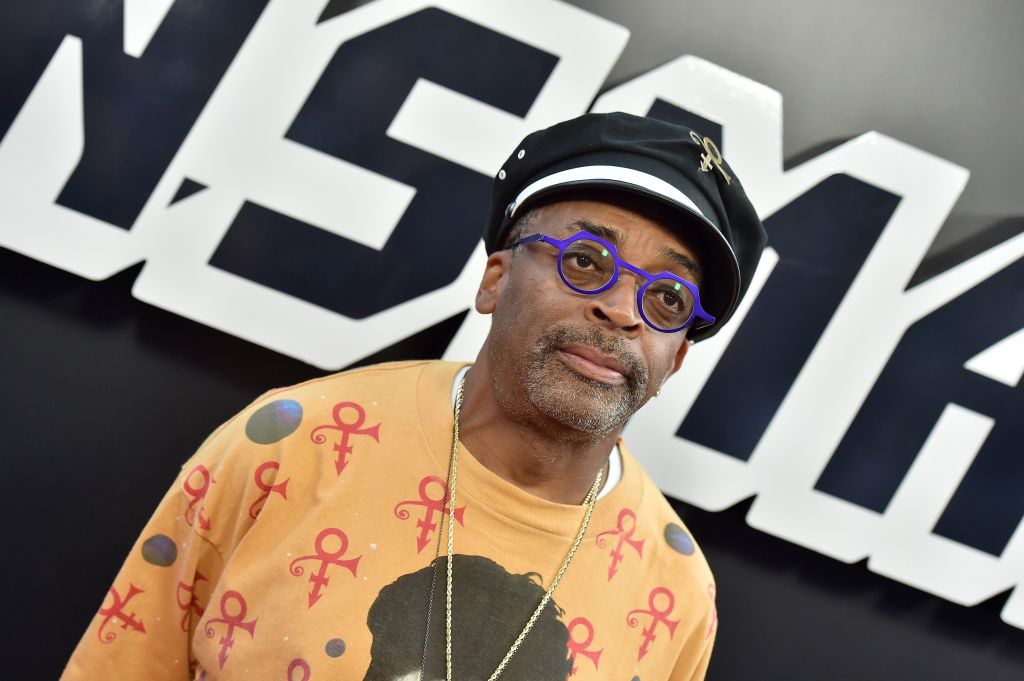
Source: Axelle/Bauer-Griffin / Getty
Spike Lee’s latest movie, BlacKkKlansman, opens with the disclaimer that it’s based on some “real fo’ real sh*t,” which is true. The movie is based on the real-life story of Ron Stallworth, a Black detective in the Colorado Springs Police Department who brilliantly infiltrated the Ku Klux Klan via phone while a white detective went undercover as him in person. Director Lee merely used Stallworth’s story (detailed in his book Black Klansman) as a palette to create a movie that is a commentary on modern-day white nationalism and Donald Trump’s ascent to the White House. Like Arthur Miller did with The Crucible before him, Spike Lee uses the past to illuminate injustices of the present. To do so, he relied largely on fictional characters and events that never actually happened, all for the service of driving home his points.
One such fictitious plot point came in the form of Connie, the wife of a Klansman, who plays a pivotal role in the movie’s climatic action sequence. Connie is never mentioned in Stallworth’s book, yet her presence in the film is integral to Lee’s argument about white women’s role in white supremacy. Her character is used her as a proxy for the 53 percent of white women who were registered voters and voted for Donald Trump in 2016.
The 53 percent, many of whom were expected to vote for the first ever female primary winner on a major party ticket, represent a dangerous and substantial sector of the American populace. These women are the Permit Pattys of the world who hide their racism in plain sight, but are always given the benefit of the doubt. Lee brings these women’s racism to light with Connie, and it’s piercing in its relevance to how Trump became president.
Connie’s actions present the central argument for why 53 percent of white women voted for Donald Trump…
The very first moment we see Connie in the film, she is being verbally abused and embarrassed by her husband, a Klan member named Felix, during a meeting they are hosting. Felix quickly dismisses Connie, insulting her in front of his peers and sending her to the kitchen to continue cooking and hosting. The movie pauses for a beat to let fans consider Connie’s plight, but not long enough for us to forget that the reason Connie interrupted the meeting in the first place was to suggest a Black student group as a target for an attack. Connie exists in two overlapping worlds: one as a woman oppressed by misogyny, and another as a white oppressor basking in racist violence. She never confronts Felix for his abuse, instead ignoring it to help him fulfill his goal of perpetuating anti-Blackness. Connie made the choice to endure male abuse for the sake of fighting for white supremacy.
Connie’s actions present the central argument for why 53 percent of white women voted for Donald Trump, a man who was caught on camera admitting to grabbing women by their vaginas and who had been accused of sexually assaulting more than a dozen women: white women care about preserving whiteness above all else, even themselves. Spike Lee used Connie as a symbol of that blind loyalty to white supremacy.
In one of the more disturbing scenes of the movie, Felix and Connie’s only romantic interaction came while fantasizing about murdering Black activists. The two are in deep embrace, with a Bible in the foreground of the camera shot, talking about the rebirth of a white nation. Connie’s giddiness (brilliantly played by Ashley Atkinson) bounces off the screen as her expressed hatred of Blackness provides her with the affection and love that she so ravenously craves from a white man.
It’s no mistake on Spike Lee’s part, then, that Felix enlists Connie to execute his most violent plan. Connie is tasked with placing a bomb at an activist rally, mostly because no one would expect the innocent white women of committing the crime. With this plot point, Lee highlights the centuries of anti-Black violence that white women have committed while maintaining the facade of innocence. It was propaganda in films like Birth Of A Nation, which promoted the idea that Black men left unchecked would rape innocent white women, that caused fervor for the KKK in the early 20th century. From Carolyn Bryant lying about Emmett Till accosting her in the street to the iconic image of Elizabeth Eckford screaming at Hazel Bryan attempting to integrate a school in Little Rock, white women have always been there right along with their male counterparts tightening the noose around Black necks without ever having to lay a finger on the rope.
Blackkklansman nails this point with one final blow, where Stallworth attempts to arrest Connie but is himself beaten by police officers who believe he’s assaulting her. As they beat Stallworth, Connie yells for them to continue the beating. The police are in the foreground of the shot as Connie is behind them, like a malicious puppet master pulling the strings of government-sanctioned racist violence.
With Connie, Spike Lee created a window into the psyche of someone who values her identity tied to racial superiority above her well-being as a woman. The point is never more salient than in 2018 as America is on the verge of a Supreme Court appointee that could threaten Roe v. Wade, and the 53 percent of white women voters who chose the president are complicit in that decision. There have been countless studies and analyses about the reasoning behind white women voting for Trump, but BlacKkKlansman plants its flag on one simple answer: nothing matters more to them than white power. Connie embodies that ideology and her presence in the film is a sobering reminder that anti-Blackness is multifaceted and enduring, evolving from planted bombs and n-words to the ballot box. It’s a reality that is as scary now as it ever was.
















